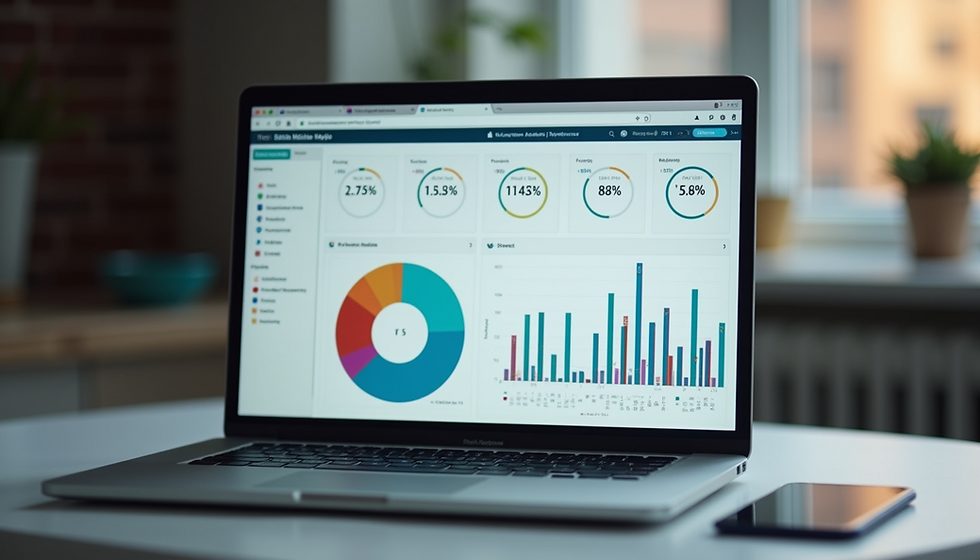Why Accessibility Is Crucial in Web Design
- April Price

- Jul 7
- 4 min read
In today's digital world, accessibility is not just a feature—it's a necessity. As the internet becomes increasingly integrated into our daily lives, web design must accommodate all users, including those with disabilities. The concept of accessible design ensures that everyone, regardless of ability or circumstance, can navigate, understand, and interact with websites effectively.

Understanding Accessible Design
Accessible design refers to the practice of creating websites that everyone can use, including individuals with disabilities. This includes people who may rely on assistive technologies like screen readers, keyboard navigation, or other adaptive tools. By prioritizing accessibility from the beginning, designers can create inclusive experiences that enhance usability for all.
The Web Content Accessibility Guidelines (WCAG) provide standards to help web developers create accessible sites. These guidelines help ensure websites are easy to navigate, have readable content, and are operable with various devices. For example, text alternatives for images allow visually impaired users to understand visual content through screen readers.
Benefits of Accessible Design
Creating accessible websites is about more than simply following regulations. It offers several significant benefits:
1. Expanding Your Audience
Statistics show that around 15% of the world's population lives with some form of disability. This diverse audience represents a significant portion of potential users. By making your website accessible, you open it up to a wider audience—ultimately increasing engagement and conversion rates.
2. Enhancing User Experience
Accessible websites enhance the overall user experience. When users can navigate your site with ease, they are more likely to stay and interact with your content. Features such as clear headings, high contrast, and easy navigation all contribute to a more enjoyable experience for every visitor.
3. SEO Benefits
Search engine optimization (SEO) and accessibility often go hand in hand. Accessible websites can improve SEO rankings because they encourage structured content, alt text for images, and proper tags. By prioritizing accessibility, you're likely enhancing your site's visibility on search engines—a win-win!

How do you make a website accessible?
Making a website accessible involves several vital strategies, techniques, and tools. Here are some practical steps to ensure your site complies with accessibility standards:
Use Semantic HTML: Leveraging the proper HTML elements helps screen readers understand your content's structure. For instance, use headings (H1, H2, H3) appropriately to establish a hierarchy of information.
Provide Text Alternatives: Always include alt text for images. This ensures that visually impaired users can comprehend your content. The alt text should concisely describe the image while being specific enough to convey the essential nature of the visual.
Implement Keyboard Navigation: Many users navigate websites using keyboards instead of mice. Ensure that all interactive elements are accessible via keyboard controls and that focus indicators are clear.
Ensure Color Contrast: Pay attention to color schemes. High contrast between background and text improves readability for individuals with visual impairments. Tools are available to check color contrast ratios.
Responsive Design: Ensure your website is viewable and functional across various devices. Responsive design allows users on mobile devices to access and navigate your site easily.
Accessibility Testing: Always test your site for accessibility. Tools like WAVE, Axe, and Lighthouse can help identify areas that need improvement. Engage users with disabilities in the testing process to gather real-world feedback.
By prioritizing these practices, you can create a website that not only meets accessibility standards but provides an exceptional user experience for everyone.

The Legal Requirements
In many regions, there are legal obligations for web accessibility. For example, in the United States, the Americans with Disabilities Act (ADA) mandates that businesses ensure equal access to their services, which extends to websites. Similarly, in the European Union, the Web Accessibility Directive specifies requirements for public-sector bodies. Failure to comply with these regulations can lead to lawsuits, making accessibility an imperative not just from a societal perspective but also from a legal one.
The Role of Accessible Website Services
Companies specializing in accessible website services can assist in strategizing and implementing accessibility features effectively. They can provide support throughout the design and development phases, ensuring that your website meets accessibility standards right from the start. These services often include audits, user testing, and design recommendations, simplifying the process of creating an inclusive digital experience.
Moving Forward: The Future of Web Accessibility
The focus on web accessibility is growing. As society becomes more aware of the need for inclusivity, the expectation for accessible design will intensify. Companies that prioritize accessibility are more likely to thrive in this evolving landscape.
By embracing accessible design principles, you not only help users with disabilities but also proactively position your brand as one that values inclusivity. As you design future projects, consider how to create platforms that are usable by all—and set an example for your peers.
Integrating accessibility into your web design strategy isn't just a trend; it's a necessary evolution to support an inclusive digital environment. When everyone can participate in the online world, we create a richer, more diverse internet that benefits every user.
In the end, accessible web design is about respect and understanding for others. Commit to creating accessible digital content and make a lasting impact on the lives of all users.





Comments